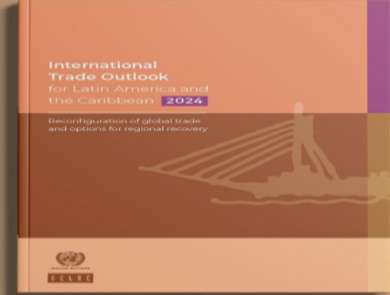SANTIAGO, Chile – The Economic Commission for Latin America and the Caribbean (ECLAC) Wednesday said that services exports from the region will increase at a double-digit rate for the fourth consecutive year
In its latest edition titled “International Trade Outlook for Latin America and the Caribbean,” ECLAC notes that after falling by one per cent in 2023 in the context of contracting global trade, regional goods exports will recover in 2024.
The report states that in order to harness high global demand for modern services, the countries of Latin America and the Caribbean should strengthen their productive policies in partnership with the private sector.
Among the priority areas are improving the measurement of services trade, strengthening the population’s digital and language skills, closing digital infrastructure gaps, and implementing programs geared towards promoting services exports and attracting Foreign Direct Investment (FDI).
FDI in particular is key to bringing in new technologies, improving productivity, and generating clusters and value chains around services, the report noted.
According to the document, the value of the region’s goods exports will grow by four per cent, reflecting a five per cent expansion in volume and a one per cent decline in prices. Imports, meanwhile, are forecast to rise four per cent in volume while falling two per cent in price, leading to a two per cent projected increase in their overall value.
By sector, the greatest projected increase in value will be seen in agricultural exports (11 per cent), followed by mining and oil (five per cent) and manufactured goods (three per cent).
By subregion, it is estimated that the biggest increases will occur in the Caribbean (23 per cent) and South America (five per cent).
This high figure for the Caribbean is due mainly to a marked increase in the volume of oil shipments from Guyana and Suriname. In South America, the increased export volume of agricultural products such as soy, corn and wheat is most notable.
By trading partner, the projections point to increased exports to China six per cent), the United States and the European Union ffive per cent. With that result, the intraregional trade ratio would fall from 14 per cent in 2023 to 13 percent this year.
Meanwhile, ECLAC forecasts that the value of regional services exports will increase by 12 per cent in 2024. This would be the fourth straight year in which these exports grow at double-digit rates, driven mainly by tourism and modern services that are provided digitally. Regional services imports, however, are projected to grow by just 1% in 2024, in line with the weak dynamism of economic activity.
Despite the recovery in regional goods and services exports, the report warns that the significant challenge of diversifying them and making them more knowledge intensive remains. ECLAC said the complexity of this challenge is even greater in a global context in which geopolitical tensions and rising protectionism call into question the type of globalization that has prevailed in recent decades, it adds.

“The implementation of productive development policies with a focus on clusters, sustained over time and based on close public-private cooperation, is an ideal mechanism both for progress in this area and for a more competitive region amid the ongoing reconfiguration of global value chains,” ECLAC executive secretary, José Manuel Salazar-Xirinachs, said at the launch of the report.
The ECLAC report also addresses the role of trade in Latin America and the Caribbean’s food security. It notes that the successive crises that have battered the world economy in recent years have caused setbacks for attaining target 2.1 of the United Nations Sustainable Development Goals (SDGs), which seeks to end hunger and ensure access by all people to safe, nutritious and sufficient food all year round by 2030.
According to the document, in Latin America and the Caribbean, hunger affected 41 million people or 6.2 per cent of the region’s population in 2023 – 4.7 million more than in 2019.
The prevalence of hunger in the Caribbean (17.2 per cent) is roughly triple the figure recorded in South America (5.2 per cent) and Central America and Mexico (5.8 per cent).
In 2023, 30.3 per cent of adult women in Latin America and the Caribbean suffered moderate or severe food insecurity, 5.2 percentage points higher than the rate for men. Food insecurity also disproportionately impacts rural populations (32.2 per cent) compared to urban populations (26 per cent).
ECLAC said in this regard, international trade plays a crucial role in food security. Imports provide access to food that is impossible or cost-prohibitive to produce locally, whether because of climate conditions or a lack of available land or technology.
“They can also supplement local production during temporary shocks, such as pest infestation, conflicts or extreme weather. Moreover, the income generated by exports can be used to purchase food.”
ECLAC noted that Latin America and the Caribbean is the world’s leading net food exporter with Its food exports reaching a record high of US$349 billion dollars in 2022.
South America accounts for the bulk of the region’s exports and surpluses, while the subregion comprising Central America and Mexico runs a small surplus and the Caribbean has a persistent deficit.
The value of food imports represents more than 20 per cent of total goods and services exports in 15 of the region’s countries, 12 of which are in the Caribbean.
ECLAC said that strengthening regional integration is essential for a more stable and lower-cost regional food supply. An integrated regional market expands the supply of food and inputs from nearby sources, which reduces exposure to supply shocks from third markets.
In addition, greater regional integration encourages the creation of production chains that promote economic and social development by generating employment, which contributes to greater food security.
To strengthen the contribution of trade to food security in the region, the report recommends making progress in several areas namely trade facilitation for food products, the harmonization or mutual recognition of sanitary, phytosanitary and technical standards, improved food trade logistics, especially in the Caribbean as well as strengthening the network of trade agreements between countries and blocs in the region; and coordination in multilateral forums.
The ECLAC’s document also examines the potential of services to boost regional exports. In a context of stagnation of per capita income in Latin America and the Caribbean in the last decade and sluggish growth in the volume of its goods exports (1.6 per cent annually for the 2014-2023 period), services exports could be a new driver of external sector growth.
In 2023, regional services exports surpassed pre-pandemic levels, totaling US$221.7 billion dollars. However, services represent just 14 per cent of the region’s goods and services exports, well below their share at a global level (25 per cent).
Among the service sectors that stand out are tourism, transportation and modern, digitally provided services. This last category had their biggest share as a proportion of exports from MERCOSUR (59 per cent), and their smallest share in the Caribbean Community’s (CARICOM) shipments abroad (10 per cent).
Tourism is the main services export in all the subregional blocs, with the exception of MERCOSUR. (CMC)
![]()














